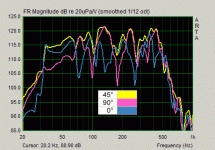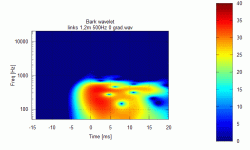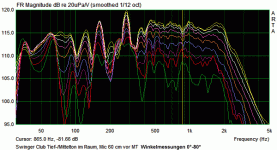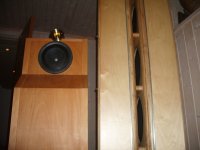My initial thought when starting this thread was to explore bass reproduction with monopoles and dipoles in a small room with rigid walls and without any absorption other than normal living room furnitures. This is living reality for many.
Let's keep it that way. Discussion requiring heavy room treatments do not really belong in this thread.
- Elias
I have just finished building a set of slot loaded open baffles, comprising of 10 x 15" drivers pr. side - these are up and playng in my 400 sq.ft.++ (40m2) regular basement room, concrete floor/walls insulated and panelled just like a regular living room. NO room treatments of any kind, just sensible placement of necessary furniture, and equippment. The room is a dedicated music room though, so care have been taken to have symmetry on everything from the speakers rear wall to well behind the ears of the listener...
This is my third large format OB bass system, and it is WAY better than anything else I have ever heard.
Top class bass for playing regular music (ridiculous surround-style foundation shakin' "bass" is of no interest) is definitely possible with OB, it is just a question of scale, quality of drivers and enough space around the speakers (and a couple of other clever tricks
 )
)And slot-loading DEFINITELY has quite a lot of directivity at least at a certain distance; the amount of energy hitting you in the sweet spot is downright scary.
Attachments
Last edited:
To my ears, dipole bass is difficult to integrate with monopole subwoofers. I've tried it many times, and every time the monopole sounded "different" than the dipoles. Hard to describe, but its a different type of sound.
Dipole subwoofers are as efficient as wood-fired steam engines... that's why we don't see them too often I guess.
There are several reasons for monopoles/dipoles etc. not gaining momentum in popularity;
1. These are very difficult to establish as commercially viable products, for obvious reasons...
2. As a result of # 1. the very same commercial market is not particularily interested in PROMOTING such solutions
3. Lots of myths and half-*** negative science around OB's and dipoles
4. Most enthusiasts building such creations have seldom taken it to the max and/or explored the combination of unorthodox techniques and components.
I can appreciate and understand all of this, but please do not write off OB/dipoles as "proper" solutions for world class bass; the more extreme and esoteric variants DO actually work, contrary to many "minimum solution" excecutions of the same theme(s). Remember the Bumble Bee's inability to fly...??
Last edited:
Not to go off topic but this slot loaded woofer thing has really gotten out of hand. Slot loading at low frequency does very little if anything in the free field. Increased directionality is not there. Certainly if you move closer to the woofer you will hear increased bass, but this is true of any dipole system because the closer you get the stronger the front source gets compared to the rear source whioch due to the differences in propagation distance. See Nelson Pass Slot loaded OB for a documented discussion of a scaled, slot loaded woofer system with many measurements.
JohnK and Dr. Gedlee:
Yes, I agree that monopole and dipole in domestic listening rooms differ mainly in EQ needed to make responses same at listening position:
Monopole Raw response:
Dipole raw response:
Cardioid system as Monopole and Dipole driving together:
Equalization is generated for Monopole, Dipole, and Cardioid. Equalization is applied to test sweep for each setup and run. Results are:
Monopole:
Dipole:
Cardioid:
Similar results are obtained with differing speaker and microphone placements. This work was done with microphone at 44 inches. It is quite clear that room response dominates, and may be equalized.
Raw Impulse responses Monopole top, Dipole bottom:
Impulse Responses with correction filters: Monopole top, Dipole bottom:
For given driver, monopole produces more output with less driver excursion, and excursion related distortions. Dipole doesn't excite walls, floor, and ceiling in null plane.
Listening impressions for equalized conditions are virtually identical: Fantastic.
Regards,
Andrew
Yes, I agree that monopole and dipole in domestic listening rooms differ mainly in EQ needed to make responses same at listening position:
Monopole Raw response:
An externally hosted image should be here but it was not working when we last tested it.
Dipole raw response:
An externally hosted image should be here but it was not working when we last tested it.
Cardioid system as Monopole and Dipole driving together:
An externally hosted image should be here but it was not working when we last tested it.
Equalization is generated for Monopole, Dipole, and Cardioid. Equalization is applied to test sweep for each setup and run. Results are:
Monopole:
An externally hosted image should be here but it was not working when we last tested it.
Dipole:
An externally hosted image should be here but it was not working when we last tested it.
Cardioid:
An externally hosted image should be here but it was not working when we last tested it.
Similar results are obtained with differing speaker and microphone placements. This work was done with microphone at 44 inches. It is quite clear that room response dominates, and may be equalized.
Raw Impulse responses Monopole top, Dipole bottom:
An externally hosted image should be here but it was not working when we last tested it.
Impulse Responses with correction filters: Monopole top, Dipole bottom:
An externally hosted image should be here but it was not working when we last tested it.
For given driver, monopole produces more output with less driver excursion, and excursion related distortions. Dipole doesn't excite walls, floor, and ceiling in null plane.
Listening impressions for equalized conditions are virtually identical: Fantastic.
Regards,
Andrew
JohnK;
Did you ever build this kind of construction in this scale yourself? I have all the mentioned systems here, and there is a very marked difference in the directivity between those regular OB's and the slot loaded version. No question. This is also usually the first comment from other listeners - some 10-12 seasoned audio friends happened to mention this particular feature. Move a foot to the left or right and it changes caracter. Listening distance is about 10 ft. right now - I can relate to your theory when we increase the listening distance but at 10' I have to relate to our EXPERIENCE rather than theory.
Mind you, this particular "concentrated energy field" was not on my mind when designing the whole concept - we just discovered it during the first listening session.
If doing SLOBS is wrong I don't wanna be right.
Did you ever build this kind of construction in this scale yourself? I have all the mentioned systems here, and there is a very marked difference in the directivity between those regular OB's and the slot loaded version. No question. This is also usually the first comment from other listeners - some 10-12 seasoned audio friends happened to mention this particular feature. Move a foot to the left or right and it changes caracter. Listening distance is about 10 ft. right now - I can relate to your theory when we increase the listening distance but at 10' I have to relate to our EXPERIENCE rather than theory.
Mind you, this particular "concentrated energy field" was not on my mind when designing the whole concept - we just discovered it during the first listening session.
If doing SLOBS is wrong I don't wanna be right.
Last edited:
Impressive data, Andrew. But your final remark keeps me curious: Do you say that with the frequency response of all 3 versions equalized to the same target the dipole-non-excitement in the null plane doesn't make a difference in listening?Dipole doesn't excite walls, floor, and ceiling in null plane.
Listening impressions for equalized conditions are virtually identical: Fantastic.
Rudolf
If one would do equalized or normalized comparisons, then time-domain ringing would be the only (possibly) remaining difference between the three source types, right? It would be interesting to see if there would be any significant difference in ringing (because of 'less' or 'fewer' mode excitation).
I’m still riding my hobby horse … the dipole woofer directivity.
It is obvious that we don’t see a figure-8 pattern below the Schroeder frequency. But the excitation of individual modes can change dramatically when the dipole source is rotated.
Measurements were taken in a 4 x 5 m room with “hard” walls except the front wall, which is a slanted ceiling in the upper half and a knee wall below. The H frame is 1.30 m from the front wall and 1.10 m from the side wall. The microphone was on the 45° axis, about 1.30 m from the H frame. 0° is along the 5 m length, 90° along the 4 m width of the room:

You can probably imagine why I choose the 45° alignment. I have processed those three impulse responses through Elias’ Bark wavelet analysis.

It is up to everybody to see for himself if it does make any difference in the time domain "ringing".
Rudolf
It is obvious that we don’t see a figure-8 pattern below the Schroeder frequency. But the excitation of individual modes can change dramatically when the dipole source is rotated.
Measurements were taken in a 4 x 5 m room with “hard” walls except the front wall, which is a slanted ceiling in the upper half and a knee wall below. The H frame is 1.30 m from the front wall and 1.10 m from the side wall. The microphone was on the 45° axis, about 1.30 m from the H frame. 0° is along the 5 m length, 90° along the 4 m width of the room:

You can probably imagine why I choose the 45° alignment. I have processed those three impulse responses through Elias’ Bark wavelet analysis.

It is up to everybody to see for himself if it does make any difference in the time domain "ringing".
Rudolf
But wasn't exactly that one point Earl was mentioning that there is virtually no directivity in small rooms at LFs ?
One always has to consider the bandwidth that is being talked about. In the modal region directivity cannot exist, but above the Schroeder frequency it can. If the bandwidth is such that it encompases both regions - as it almost always does for dipole speaker systems - then one cannot easily determine if the sound quality difference is due to the range below fs or above. So lets say that a dipole system is deemed to "sound better" (and I for one am not ready to accept that premise as unconditional) then it could be the differences in the "directional possible" region or it could be the other region. We just do not have any data (that I have seen) to make that determination.
I have said that, on paper, a dipole has an advantage from 125 Hz up to about 500 Hz, but dipoles also have disadvantages as well. I consider these two octave to be just about the least important perceptually so it becomes a real mixed bag as far as a dipole being the ideal. From the examples that I have heard, the dipoles did seem to be very good in this region, but thir poor performance elsewhere left them lacking IMO. (And no I won't point out the specific dipoles that I have heard - they were well regarded however.)
But to me that means that there are leftovers from directivity, no ?I’m still riding my hobby horse … the dipole woofer directivity.
It is obvious that we don’t see a figure-8 pattern below the Schroeder frequency. But the excitation of individual modes can change dramatically when the dipole source is rotated.
Yes, I was quoting you with <125Hz in mind.One always has to consider the bandwidth that is being talked about.
And thanks to John for the measurements and time time you have invested !
Last edited:
But to me that means that there are leftovers from directivity, no ?
Yes, that is correct. The more overlapping modes that get excited the more the "pattern" can begin to converge on the dipole or cadiod. At very LFs where only a single mode typically gets excited, the wave in the room can only follow the direction defined by that mode (its mode shape) . As more and more modes gets excited then the wave can move in more and more directions until at high modal density the wave can propagate in an arbitrary direction.
It depends on how we define directivity. In my polar measurements I can clearly see the figure 8 above the Schroeder frequency and several distinct mode frequencies below, which are individually more or less excited depending on the rotation angle. Of course some modes (diagonal/vertical) are less or not susceptible to rotation.But to me that means that there are leftovers from directivity, no ?
I really wonder if a "prepared" room like John's or Earl's would show less change of room modes with dipole woofer rotation.
Rudolf
With regard to the SLOB woofer all I'm am saying is that the idea that it increases efficiency and alters directivity in the far field, at low frequency, compared to any other dipole format is just a crock. Now, what happens in the free field is a far cry from what happens in the near filed, or what happens in a room. Compared to flat baffle woofer system the sources are in different places and how they excite modes is different. It follows that what you will hear will be different as well.
The thing is that when we introduce a room there is no far field. There is only the distribution of the sources and the room. Actually, it makes no sense to consider a dipole or cardioid as a single source in any typical acoustically small room. They are composed of two or more sources with different phase and delay. And each source interacts with the room differently.
I will be posting the impulse responses for my test later today. I had to set the woofer up again so they may not be the exact same as the impulses which I used previously but they will be close.
Now, the CRAW woofer is composed of two identical drivers mounted in separate compartments of a single enclosure. One driver fires out the back, one out the front. They are separated by a front to back distance 18". When I post the impulse responses I will also post a comparison of the monopole impulse when only the front source is connected and another impulse when both front and rear sources are connect. This simple turning on of the rear source of the monopole has a significant effect on both the impulse and the frequency response. My point here is that when every you make a change to a woofer system how it interacts with the room is very dependent on exactly where the individual sources are located. So if a slot loaded woofer system sounds different that a previous OB woofer system it may well have more to do with how it connects to the room than anything else.
The thing is that when we introduce a room there is no far field. There is only the distribution of the sources and the room. Actually, it makes no sense to consider a dipole or cardioid as a single source in any typical acoustically small room. They are composed of two or more sources with different phase and delay. And each source interacts with the room differently.
I will be posting the impulse responses for my test later today. I had to set the woofer up again so they may not be the exact same as the impulses which I used previously but they will be close.
Now, the CRAW woofer is composed of two identical drivers mounted in separate compartments of a single enclosure. One driver fires out the back, one out the front. They are separated by a front to back distance 18". When I post the impulse responses I will also post a comparison of the monopole impulse when only the front source is connected and another impulse when both front and rear sources are connect. This simple turning on of the rear source of the monopole has a significant effect on both the impulse and the frequency response. My point here is that when every you make a change to a woofer system how it interacts with the room is very dependent on exactly where the individual sources are located. So if a slot loaded woofer system sounds different that a previous OB woofer system it may well have more to do with how it connects to the room than anything else.
I really wonder if a "prepared" room like John's or Earl's would show less change of room modes with dipole woofer rotation.
Rudolf
I'll be taking some additional measurement today. I'll look at rotating the dipole. But remember, rotating the dipole changes the location of the sources. That will change the result.
Thanks in advance. I would have thought, that any of your dipoles would be a point source below the Schroeder frequency.But remember, rotating the dipole changes the location of the sources. That will change the result.
My dipoles were on a lazy Susan while being measured from 60 cm distance in the room:

I think above diagram looks like a textbook example
Rudolf
I really wonder if a "prepared" room like John's or Earl's would show less change of room modes with dipole woofer rotation.
Rudolf
In theory as the modes become more damped they broaden and overlap more. This means that there is always a greater modal interaction and hence more of a high modal density response. This is why the Schroeder Frequency varies with the reverberation time - higher damping lowers this frequency and lowers the discrete modal effects below it as well. Damping at LFs is always a good thing in a small room. But getting high LF damping without HF damping is a very tricky business - it's almost always the other way arround.
measured from 60 cm distance in the room:
I think above diagram looks like a textbook example
Rudolf
At that distance its all direct field data, not room data. Of course you see the polar effect. In the reverberant field you won't.
To my ears, dipole bass is difficult to integrate with monopole subwoofers. I've tried it many times, and every time the monopole sounded "different" than the dipoles. Hard to describe, but its a different type of sound.
Agree...the only reason I got into dipole woofers at the first place was to augment the LF for my Magnepans. Not even "2 way" monopoles with different subs one for midbass 50-100Hz(HSU Mid bass module) and a second subwoofer for ultra low bass (< 50Hz)could blend with dipole main speakers. Finally MJK alpha 15 Hframes did the trick to seamlessly integrate with Magnepan mains.
Even with the same diameter drivers, equalised to same LF extension, listened at moderate SPL, to even nearfield (2-3 Meters) there is that slight overhang in sealed units that makes it sound like a "speaker" which is not apparent in a dipole(H or Uframe) making it sound that last bit different ... or "natural'. No scientific logic/evidence "yet" discovered....Wonder if it is the lower group delay in the dipole which is small yet audible
Last edited:
Looking at the long ringing impulse response of the dipole in post #444 perhaps it's that. Thats a very long group delay in the room response.
In post #444, the second graph from the bottom titled "Raw Impulse responses Monopole top, Dipole bottom" was actually a bit confusing to me. For the monopole the region from the impulse upto .02ms looks crowded, but for the dipole this is clean. However after .02ms there is pronounced ringing in the dipole response; much more than the monopole response.
Does this mean that the dipole is cleaner before .02ms compared to the monopole. However after .02ms the monopole is cleaner....is this the reflected soundfield because of room reverberation.....but if the room is the same, so should be the reverberation time. In any case after .02ms why is there more overhang in the room for the dipole than the monopole.
Please explain. Thanks.
Last edited:
- Status
- This old topic is closed. If you want to reopen this topic, contact a moderator using the "Report Post" button.
- Home
- General Interest
- Room Acoustics & Mods
- Measured monopole and dipole room responses
